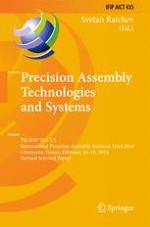This book constitutes the refereed post-proceedings of the 7th IFIP WG 5.5 International Precision Assembly Seminar, IPAS 2014, held in Chamonix, France, in February 2014. The 20 revised full papers were carefully reviewed and selected from numerous submissions. The papers cover the following topics: micro-assembly processes and systems ranging from desktop factory automation and packaging of MEMS to self-assembly processes and platforms; handling and manipulation, including flexible gripper systems, fixturing and high precision actuators; tolerance management and error-compensation techniques applied at different scales of precision assembly; metrology and quality control; intelligent assembly control; process selection, modelling and planning.
